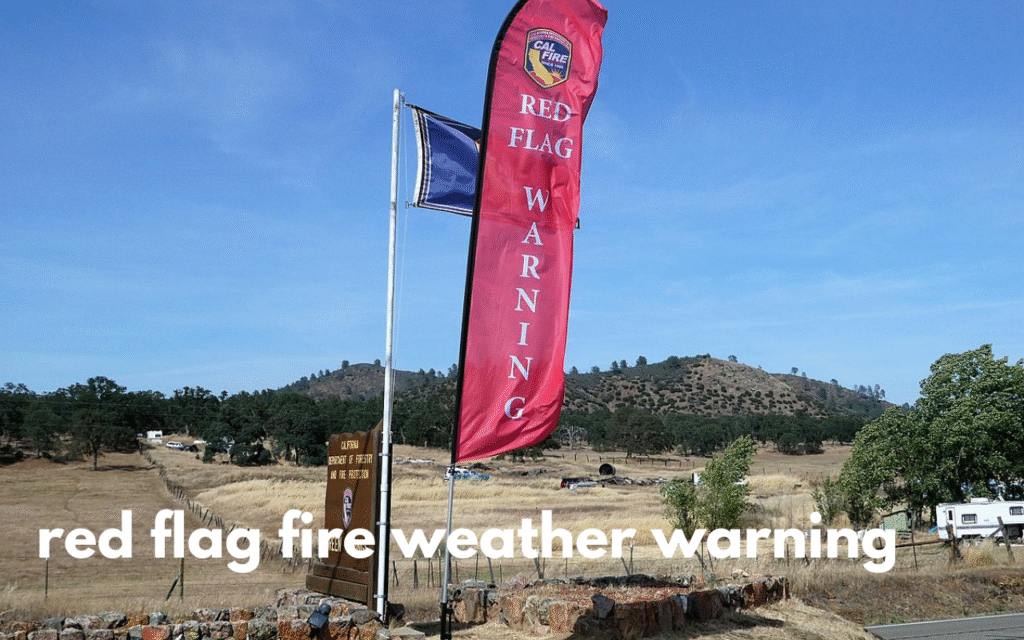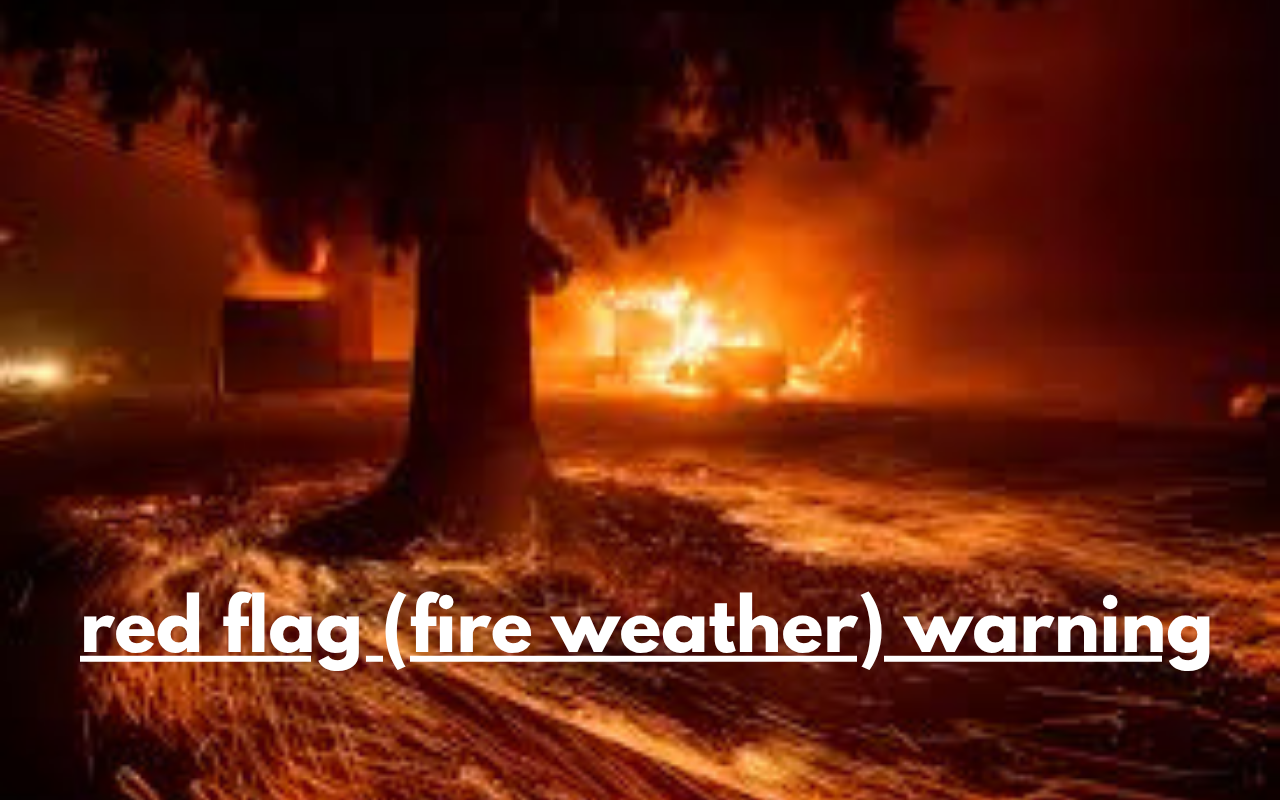Understanding Red Flag Fire Weather Warnings: What You Need to Know
Fire safety is a critical concern, especially for those living in wildfire-prone regions. One of the most essential tools in preventing wildfires and mitigating risks is the Red Flag Fire Weather Warning, a crucial alert system used by meteorologists and fire professionals to inform the public about dangerous fire conditions. This warning signifies that the environmental conditions are ripe for rapid fire spread, making it a critical period for heightened caution.
A Red Flag Fire Weather Warning is not a prediction of a fire, but a warning that the conditions are ideal for fires to ignite and spread uncontrollably. Red Flag Fire Weather Warnings These warnings are issued when specific factors like high winds, low humidity, and dry conditions create a significant risk. Understanding what a Red Flag Warning is and how to respond can help reduce the risk of wildfires and safeguard lives, property, and the environment.
In this article, we will explore what a Red Flag Fire Weather Warning is, the key factors that lead to such warnings, the impact on communities, and regional differences in fire weather risks. By the end of this article, you’ll be well-equipped to recognize these warnings and take the necessary steps to stay safe.
What is a Red Flag Fire Weather Warning?

A Red Flag Fire Weather Warning is issued by the National Weather Service (NWS) when certain weather conditions create a heightened risk for wildfires. Red Flag Fire Weather Warnings The primary purpose of this warning is to alert the public, fire professionals, and emergency responders about dangerous fire weather conditions, helping them take preventive measures to avoid fire outbreaks.
The warning is triggered when certain weather elements combine to create a fire-prone environment. These include high winds, low humidity, dry vegetation, and warm temperatures. Red Flag Fire Weather Warnings When these elements align, they make fires more likely to spread quickly and uncontrollably, even with a small spark. For instance, a gust of wind can carry an ember over long distances, causing a fire to jump firebreaks or spread into areas that would otherwise be protected.
Red Flag Warnings differ from other weather warnings, such as tornado or flood warnings, because they focus specifically on fire hazards. Red Flag Fire Weather Warnings While tornado warnings, for example, deal with severe winds and rain, Red Flag Warnings are designed to highlight fire danger, emphasizing the need for extreme caution in outdoor activities that could start a fire, such as grilling or lighting fireworks.
Key Factors That Lead to Red Flag Conditions
Several factors contribute to the issuance of a Red Flag Fire Weather Warning, all of which create conditions that favor the ignition and spread of wildfires. Red Flag Fire Weather Warnings Understanding these factors helps explain why certain areas are more prone to fire hazards during specific times of the year.
Dry Conditions and Drought
One of the key drivers of Red Flag conditions is dryness, often exacerbated by drought conditions. Vegetation, including grasses and trees, require moisture to thrive. When rainfall is scarce or absent over extended periods, vegetation dries out, creating an abundant fuel source for wildfires. Red Flag Fire Weather Warnings During periods of extreme drought, even the smallest spark can ignite a blaze that quickly spreads through dry foliage, causing a massive fire.
High Winds
Winds play a crucial role in the spread of wildfires. Red Flag Fire Weather Warnings When wind speeds are high, fires can spread rapidly, jumping across roads, rivers, and firebreaks. High winds make it difficult for firefighters to control fires and often result in fires becoming much larger and harder to manage. During Red Flag Warnings, winds typically exceed 20 miles per hour (32 km/h), making it easy for fires to travel far distances, especially in areas with dry vegetation.
Low Humidity
Low humidity creates an environment where vegetation and fuel sources (such as grass, trees, and shrubs) lose moisture more quickly. Low moisture levels increase the flammability of plant material, making it easier for fires to ignite and spread. Red Flag Fire Weather Warnings When humidity levels drop below 30% (and sometimes even lower), the conditions are ripe for a wildfire to start and escalate uncontrollably.
Warm Temperatures
Warm temperatures contribute to the drying of vegetation and further exacerbate drought conditions. High temperatures reduce the moisture in both soil and plant life, turning even the smallest spark into a potential wildfire. Red Flag Fire Weather Warnings When coupled with dry conditions and high winds, high temperatures create an extremely dangerous combination for wildfires.
What Happens During a Red Flag Warning?
When a Red Flag Fire Weather Warning is issued, it signifies an urgent need for safety precautions and heightened awareness. These warnings usually span over a specific period, and their purpose is to inform the public of the increased risk of wildfires. Red Flag Fire Weather Warnings Here’s what happens during a Red Flag Warning and what actions should be taken:
Public Impact and Urgency
A Red Flag Warning signals that fire risk is high, and everyone should take steps to minimize fire hazards. During this time, residents are advised to avoid outdoor activities that can spark fires, such as using fire pits, grilling, or lighting fireworks. In certain areas, even smoking outside or driving over dry grass can trigger a fire. Red Flag Fire Weather Warnings These activities should be postponed or conducted in controlled, safe environments.
The warning period typically lasts for several hours or days, depending on how long the hazardous conditions persist. Local authorities may also issue other alerts, such as evacuation notices or road closures, if fire danger becomes critical.
Safety Precautions
People living in areas affected by Red Flag Warnings should be prepared to act quickly. This includes having an evacuation plan in place, keeping firefighting tools like hoses and shovels accessible, and ensuring that homes and buildings are defensible against wildfires. Red Flag Fire Weather Warnings Ensuring defensible space around structures (e.g., clearing brush, cutting back trees) can reduce the chances of a wildfire threatening one’s property.
Emergency responders, including firefighters and police, also take special precautions during Red Flag conditions. Firefighters prepare by positioning equipment in strategic locations, ready to respond quickly if a fire ignites. Red Flag Fire Weather Warnings In some cases, additional resources, such as air support (helicopters and planes), may be mobilized to contain fires more rapidly.
Regional Differences in Red Flag Fire Weather
The risk of Red Flag conditions varies widely across the United States due to geography, climate, and seasonal variations. Some regions experience Red Flag warnings more frequently than others, often because they are more prone to conditions like droughts, heatwaves, and high winds.
California, the Southwest, and the Pacific Northwest
In areas like California, the Southwest, and the Pacific Northwest, Red Flag conditions are a frequent occurrence, particularly during summer and fall. Red Flag Fire Weather Warnings These areas often face extended drought periods and experience extreme heat, which dries out vegetation. Additionally, the Santa Ana winds in Southern California are notorious for quickly spreading wildfires across the region.
Wildfire-Prone Areas in the Eastern U.S.
While the East Coast is not as frequently affected by Red Flag conditions as the West Coast, areas such as Florida and parts of Texas can experience conditions conducive to wildfires during hot, dry spells. For instance, the dry winter months in Florida can create prime conditions for wildfires, and when combined with sudden temperature increases, it can trigger a Red Flag warning.
Seasonal Variations and Changing Weather Patterns
Seasonal variations play a large role in fire weather conditions. Red Flag Fire Weather Warnings In regions with colder winters, the spring and summer months tend to bring lower humidity levels, and vegetation that has been dormant throughout winter can quickly dry out, creating fire hazards. Moreover, changing weather patterns, such as El Niño or La Niña, can exacerbate droughts and increase the likelihood of Red Flag warnings.
Conclusion
Red Flag Fire Weather Warnings are crucial alerts that help protect lives and property during dangerous fire conditions. By understanding the factors that lead to these warnings, such as dry conditions, high winds, and low humidity, individuals can take preventive measures to reduce the risk of fire ignition and spread. While Red Flag conditions may vary by region, everyone should be aware of the risks and stay informed during fire-prone seasons.
In wildfire-prone areas, preparation is key. Whether it’s by creating defensible spaces around homes, avoiding fire-starting activities, or simply being ready to evacuate if necessary, staying alert during Red Flag Warnings can save lives and minimize damage. Always listen to local weather services and fire authorities, and take the necessary precautions to stay safe.
Frequently Asked Questions (FAQs)
What should I do if a Red Flag Fire Weather Warning is issued in my area?
Avoid outdoor activities that could start a fire, stay indoors, and monitor local news for updates. Ensure your property is defensible against fires.
How long do Red Flag Warnings typically last?
A Red Flag Warning can last from a few hours to several days, depending on how long the hazardous conditions persist.
Are Red Flag Warnings only issued during the summer months?
While most Red Flag Warnings occur in the summer and fall, they can also occur during unusually dry or windy conditions at any time of the year.
What is the difference between a Red Flag Warning and a Fire Weather Watch?
A Fire Weather Watch indicates that conditions are favorable for a Red Flag Warning, but the risk is not yet critical. A Red Flag Warning is issued when the risk of fire is imminent.
Can Red Flag conditions be predicted far in advance?
While Red Flag conditions can be forecasted based on weather patterns, they are often issued within 24 to 48 hours of the anticipated fire risk.
You May Also Read: https://otswroldtime.com/wp-admin/post.php?post=491&action=edit












Post Comment